Physical Address
304 North Cardinal St.
Dorchester Center, MA 02124
The immune system functions to prevent and impede the local establishment or systemic dissemination of bacteria, viruses, fungi, and protozoa. This highly complex system has to recognize the pathogen, initiate inflammation, and generate antibodies and T-cell responses with the goal of clearing the pathogen while retaining immunologic memory toward the pathogen. Furthermore, it must accomplish this task without excessive inflammation or the development of autoimmunity, both of which can lead to tissue damage. A common symptom of the immune response to infection is fever.
The differential diagnosis for patients with recurrent fevers is formidable in view of the complexity of the immune system, as well as the multitude of causes of fever. Fever can occur with any inflammatory stimulus, whether that be infections, autoimmune disorders, malignancy, or due to rare genetic variants that lead to spontaneous inflammation or autoimmunity, known as autoinflammatory disorders or immune disregulation disorders, respectively. Fever is a challenging issue for providers and causes considerable angst in families. It is helpful to have a consistent stepwise approach to a patient with recurrent fevers, keeping the differential diagnosis of fevers in mind.
Evaluation of fever should always start with a history and physical exam to look for an infectious source. Fevers without a clear infectious source should raise the possibility of an autoimmune disorder or malignancy as fevers in these disorders can be episodic; however, other symptoms are usually present that persist following resolution of the fever. Recurrent or persistent rashes, arthritis, weight loss, or abdominal pain may initiate a work-up for autoimmune diseases such as inflammatory bowel disease or juvenile arthritis or could represent an immune disregulation disorder. Basic lab testing to look for progressive hematologic abnormalities may lead to a work-up for malignancy. Inflammatory markers, including ESR or CRP, can be useful between febrile episodes, as normalization of inflammatory markers between fever episodes is unusual in ongoing autoimmune diseases or malignancies.
Recurrent infections need to be assessed by their severity and location, the responsible organisms, and the age of the patient. A young child with intermittent viral upper respiratory or gastrointestinal infections or recurrent ear infections is the norm, and reassurance and follow-up are all that is necessary with the expectation that these episodes will improve and eventually resolve over time. Recurrent bacterial infections may initiate a more in-depth immune work-up to evaluate for a primary immune deficiency, particularly if these are persistent or occur in unusual sites or with unusual organisms. Although there are no established rules regarding immunologic work-up of a patient with infections, an evaluation should be considered for at least one of the following: (1) more than two systemic bacterial infections (sepsis, meningitis, osteomyelitis); (2) two or more serious respiratory infections (pneumonia) or bacterial infections (cellulitis, draining otitis media, lymphadenitis) per year; (3) the presence of an infection at an unusual site (hepatic or brain abscess); (4) infections with unusual pathogens ( Aspergillus pneumonia, disseminated candidiasis, or infection with Serratia marcescens , Nocardia species, or Burkholderia cepacia ); (5) infections of unusual severity (pneumonias complicated by empyema or abscesses); and (6) recurrent mycobacterial infections or invasive infections with atypical mycobacteria. Persistent and recurrent fever episodes without infectious sources that don’t resolve over time could represent an autoinflammatory disorder, and genetic testing could be pursued.
The history must determine the frequency of fevers, associated symptoms, presence of an infection, and whether the patient returns to a normal state of health in between these episodes. Resolution of fever but persistence of other symptoms or lab abnormalities (e.g., anemia, ESR, CRP) should raise the possibility of autoimmune disease or malignancy. Regarding recurrent fevers with infections, the clinician must determine (1) the frequency, location, severity, and complications of the infections; (2) the accuracy of how infections were documented; (3) the presence or absence of a symptom-free interval; (4) the microbiologic features of any isolate; and (5) the response to antibiotic therapy. A single chronic infection may wax and wane with intermittent, inadequate treatment and may manifest as a series of infections. Furthermore, a detailed history can elucidate other risk factors for recurrent infections. Many nonimmune disorders are characterized by an increased susceptibility to infection that must also be considered ( Table 54.1 ). Approximately 30% of children with recurrent sinopulmonary symptoms can be categorized as atopic (genetic predisposition to develop allergic diseases). These subjects have normal growth and development, and episodes of recurrent illness may be afebrile, respond poorly to antibiotics, and be accompanied by upper respiratory symptoms such as coughing, sneezing, or wheezing. There may be a family history of atopic disease, and the patient’s past medical history may include episodic wheezing, protracted cough after upper respiratory tract infection (URI), hay fever, allergies to foods, or eczema. The physical examination of allergic school-aged children may reveal typical characteristics including the following: dark circles under the eyes; open mouth with dry lips; coated tongue; evidence of nasal obstruction; transverse nasal crease; boggy, pale nasal mucosa; mucus in the pharynx; posterior pharyngeal “cobblestoning”; and postnasal drip.
| Predisposing Causes | Organism and Type of Infection |
|---|---|
| Alteration of Mucocutaneous Barriers | |
| Indwelling Catheter | |
| Central venous catheter (Broviac, Hickman) | Staphylococcus aureus ; Staphylococcus epidermidis ; and Bacteroides , Candida , Pseudomonas species: bacteremia, fungemia |
| Urinary catheter | Escherichia coli , Enterococcus species, Staphylococcus saprophyticus : pyelonephritis |
| Tenckhoff catheter (continuous ambulatory peritoneal dialysis) | S. epidermidis , S. aureus , Escherichia coli , Pseudomonas aeruginosa , Candida species: peritonitis |
| Cerebrospinal fluid shunts | S. epidermidis , S. aureus , diphtheroid, Bacillus species: meningitis |
| Aspirated pulmonary foreign body | S. aureus , anaerobes: pneumonia, pulmonary abscess, empyema |
| Burns | P. aeruginosa , S. epidermidis , Candida species: cutaneous lesions, sepsis |
| Inhalation Therapy: Contaminated Solutions | P. aeruginosa , Serratia marcescens , Legionella species: pneumonia |
| Surgical Wounds | |
| Abdominal | Gram-negative bacteria, S. aureus, S. epidermidis, Candida species: peritonitis |
| Nongastrointestinal | S. aureus, S. epidermidis, streptococci, gram-negative bacteria: wound abscess, sepsis |
| Fistula-Sinus Communications | |
| Neurocutaneous fistula | S. aureus, S. epidermidis, E. coli : meningitis |
| Neuroenteric fistula | Gram-negative bacteria: meningitis |
| Otic, facial sinus–meningeal sinus tract | Pneumococcus: meningitis |
| Facial sinus fracture (CSF rhinorrhea) | Pneumococcus: meningitis |
| Intravenous Drug Abuse | S. aureus, P. aeruginosa, streptococci: endocarditis, osteomyelitis: hepatitis B, C, D viruses: AIDS |
| Prosthetic Devices | |
| Cardiac valves | S. epidermidis, streptococci, S. aureus , diphtheroid, Candida species: endocarditis |
| Pacemaker | S. epidermidis, S. aureus, Candida species: subcutaneous pocket or endocardial infection |
| Chronic Disease | |
| Malnutrition | Measles; tuberculosis; herpes simplex virus; bacterial, parasitic, and viral diarrhea; gram-negative bacteria: sepsis, pneumonia |
| Cystic fibrosis | S. aureus, H. influenzae, mucoid P. aeruginosa, Burkholderia cepacia ; pneumonia |
| Diabetes mellitus | Urinary tract infections, Mucor, and other fungi: sinus-orbital infection |
| Nephrotic syndrome | Pneumococcus , E. coli: peritonitis |
| Uremia | S. aureus, gram-negative bacteria, fungi: sepsis, soft tissue infection |
| Cirrhosis, ascites | Pneumococcus , E. coli: peritonitis |
| Prolonged broad-spectrum antibiotic therapy | Candida species, Enterococcus species, multidrug-resistant gram-negative or gram-positive bacteria: sepsis |
| Spinal cord injury | Gram-negative or gram-positive bacteria: pneumonia, pyelonephritis, pressure sores, abscesses, osteomyelitis |
| Sickle cell anemia | Pneumococcus : sepsis, meningitis, osteoarticular infection |
| Salmonella species, S. aureus: osteomyelitis | |
| Congenital heart disease | S. aureus, Streptococcus viridans group: endocarditis |
| Urinary tract anomaly | E. coli, S. saprophyticus, Enterococcus species: pyelonephritis |
| Kartagener syndrome (dysmotile cilia) | H. influenzae, Moraxella catarrhalis, Pneumococcus : pneumonia, sinusitis |
| Eczema/atopic disease | S. aureus, Streptococcus species, varicella, herpes simplex, molluscum: cutaneous infection, cellulitis |
| Protein-losing enteropathy (lymphangiectasia) | Pneumococcus: sepsis, peritonitis |
| Giardia species: diarrhea | |
| Periodontitis | Fusobacterium species: cellulitis, facial space infection |
| Splenic Dysfunction (e.g., Sickle Cell Anemia/Asplenia) | S . pneumoniae : sepsis, meningitis H. influenzae type b: sepsis, meningitis N. meningitidis : sepsis, meningitis Capnocytophaga canimorsus Babesiosis Malaria Group B Streptococcus Enterococcus Bacteroides Salmonella |
Malnutrition and specific vitamin deficiencies may alter immune cell function. Protein-losing states due to gastrointestinal (e.g., inflammatory bowel disease, protein-losing enteropathy) or renal disease (e.g., nephrotic syndrome) may lead to hypocomplementemia, hypogammaglobulinemia, and recurrent infections. Chronic treatment with corticosteroids and other immunosuppressants can result in acquired immunodeficiency with hypogammaglobulinemia, lymphopenia, and recurrent infections.
The clinician should determine if there was exposure to maternal viral infection during gestation (HIV, cytomegalovirus [CMV], herpes simplex virus, rubella) or a history of prematurity, blood transfusions, respiratory distress syndrome, or other pertinent neonatal illnesses. Infants previously placed on ventilators may develop chronic obstructive lung disease (bronchopulmonary dysplasia), predisposing them to recurrent pulmonary infections. Most perinatal HIV infections are seen in children whose mother or mother’s partner has engaged in high-risk behavior (i.e., multiple sex partners or use of intravenous drugs). Attention should be paid to the time of umbilical cord separation since infants with a history of delayed umbilical cord separation and recurrent episodes of sepsis or pneumonia should be evaluated for leukocyte adhesion deficiency .
Recurrent infections in primary immune deficiencies typically affect different anatomic locations. Structural or anatomic defects often result in recurrent infections that are generally localized to the affected organ system. Approximately 10% of children with recurrent infections have an underlying chronic disease or a structural defect that predisposes them to recurrent infections (see Table 54.1 ).
Eustachian tube abnormalities or cleft palate results in recurrent or chronic otitis media; congenital heart disease results in an increased risk of endocarditis; and posterior urethral valves, vesicoureteral reflux, or ureteral pelvic junction obstruction results in recurrent urinary tract infections. Recurrent pneumonia may result from congenital malformations (trachea-esophageal fistulas, cystic adenomatoid malformation, or sequestration), from aspiration of a foreign body (peanut, small toys) or chronic aspiration (gastroesophageal reflux, swallowing disorders, neurologic diseases), and from bronchopulmonary dysplasia. Repeated pneumonias in dependent lobes warrant evaluation for recurrent aspiration. Chronic illnesses that result in recurrent pulmonary infections include cystic fibrosis, primary ciliary dyskinesia, or α 1 -antitrypsin deficiency. Recurrent sinus infections can occur due to anatomic defects of the sinuses (polyps, stenotic os). Endotracheal intubation predisposes the patient to recurrent pulmonary infections with nosocomial organisms. Right middle lobe syndrome and sequestered lung can appear as recurrent pneumonia in the same anatomic location.
Any direct communication to the cerebrospinal fluid that bypasses the blood-brain barrier predisposes patients to a central nervous system infection. Basilar skull fractures and dermal sinus tracts or fistulas may communicate with the subarachnoid space or neural tissue. Other conditions predisposing patients to opportunistic infections of the central nervous system include penetrating foreign body, cerebrospinal fluid shunts, myelomeningocele, and encephalocele. Local infections of the sinuses or of the middle ear may spread to contiguous structures to form cerebral abscesses or subdural-epidural empyema. Intravenous drug use, bacterial endocarditis, and heart disease with right-to-left shunt are associated with an increased risk of central nervous system infections.
The spleen plays a particularly important role in preventing invasive infections, especially during the first year of life before specific immunity to certain bacteria has developed. The spleen is able to bind and phagocytose encapsulated bacteria and produces natural antibodies against polysaccharides that cross react with the cell walls of bacterial pathogens, thereby providing a critical role in preventing sepsis in immunologically immature subjects from encapsulated bacteria. The spleen is also an important location for the phagocytosis of complement and antibody opsonized bacteria, and a key location for the production of antibodies.
Functional asplenia occurs in children with sickle cell disease, initially as a result of vascular occlusion by the sickle cells in the splenic circulation. Congenital absence of the spleen may occur alone or as part of an asplenia syndrome with congenital heart disease. Heterotaxy and disorders of left-right patterning can result in polysplenia in which the spleens are not functional. Genetic variants in NKX2 and ribosomal protein SA have been found in a small number of patients with congenital asplenia. Trauma and surgical splenectomy are also important causes of asplenia.
Individuals without spleens (anatomic or functional) are subject to a severe form of sepsis that is rapid in onset and can lead to sudden death if it is not recognized and treated promptly. Pneumococci are responsible for more than 50% of such infections; infections with Haemophilus influenzae , Staphylococcus aureus , group A streptococci, gram-negative enteric bacilli, and meningococci also occur (see Table 54.1 ).
The diagnosis of anatomic or functional asplenia is suggested by the presence of red blood cell inclusions, particularly Howell-Jolly bodies on peripheral blood smear. Failure of uptake of technetium 99–sulfur colloid, which is normally taken up by the entire reticuloendothelial system, and lack of erythrocyte pitting are also noted in asplenic patients. Lack of a spleen by ultrasonography of the abdomen is suggestive of asplenia, but accessory splenic tissue may still be present. Functional tests of splenic tissue are a better indicator of asplenia.
The risk of fulminant infection in patients who have undergone splenectomy (from surgery or trauma) or in those with functional asplenia or congenital asplenia is highest in the first few years. The risk is lower in older children and in adults, probably because they have developed opsonizing antibodies through previous exposure. The management of functional or anatomic asplenia lies mainly in prevention. When splenectomy becomes necessary, partial protection against life-threatening infections can be obtained by immunizing patients with conjugated and polyvalent pneumococcal , H. influenzae type b, and meningococcal vaccines. Booster immunization may be needed because of waning immunity with time. Prophylactic antibiotics may be given continuously in a single daily dose for 1–3 years or up to the age of 16 years (some authorities suggest longer periods or even for life) after splenectomy. Parents of older asplenic children are advised to have their children seen by a physician or to administer the antibiotics at the first sign of a febrile illness.
Specific patterns of inheritance have been determined for a variety of immunologic defects resulting in immune deficiency or autoinflammatory disorder. Genetic defects of immunity can be inherited as X-linked, autosomal recessive, or autosomal dominant disorders. Monogenic primary immunodeficiencies and autoinflammatory disorders may exhibit reduced penetrance (some people with the genetic abnormality do not exhibit a clinical phenotype) and variable expressivity (different signs and symptoms with the same genetic defect). A family history of unexplained infant deaths or serious infection should be sought, particularly in male infants since a number of important immune deficiencies are X-linked. Evidence of consanguinity should also be established as many serious primary immune deficiencies are autosomal recessive. Since allergic diseases can appear as recurrent infections, a family history of atopy is important. A child who has one allergic parent or two allergic parents will develop an atopic disease in 25% and 50% of cases, respectively. Some autoinflammatory disorders are more prevalent in subjects from certain geographic regions (e.g., familial Mediterranean fever), and many have an autosomal dominant inheritance pattern, and therefore a family history of fevers should be sought.
Respiratory and dermatologic findings are a result of exposure to environmental allergens and toxins. Specific bacteriologic and parasitic exposures are associated with certain pets (i.e., Salmonella organisms and iguanas or turtles; psittacosis and birds; Bartonella organisms in kittens). A travel history may suggest exposure to unusual organisms that are regionally endemic, such as certain parasites and specific insect or animal bites, or to contaminated water. A move to a new house or to a new nursery school or exposure to a new babysitter, pet, or housekeeper may suggest possible allergic and infectious risks.
The physical examination may provide important clues to the diagnosis of a primary immune deficiency or autoinflammatory disorder. Longitudinal evaluation of height and weight is crucial in identifying infants with failure to thrive or acute weight loss. Some immune deficiencies are associated with skeletal dysplasia or growth deficiency in addition to failure to thrive. Chronic upper respiratory infections are suggested by scarred tympanic membranes, postnasal drip, and cervical adenopathy. Transverse nasal creases, circles under the eyes, and posterior pharyngeal “cobblestoning” suggest respiratory allergy. Recurrent cough, wheezing, digital clubbing, and chest deformity are suggestive of pulmonary disease. Recurrent aphthous stomatitis can be a sign of a serious systemic disorder such as immune deficiency, an autoinflammatory disorder, autoimmunity, or inflammatory bowel disease. Auscultation of the apex of the heart in the right side of the thorax (dextrocardia) may be accompanied by ciliary motility abnormalities or asplenia. Lymphadenopathy, hepatosplenomegaly, pallor, wasting, and recent weight loss are suggestive of systemic disease. Absence of lymph tissue (tonsils and lymph nodes) is suggestive of a B-cell deficiency, while absence of thymic tissue on chest radiograph in an infant is suggestive of T-cell deficiency. Parotid enlargement with lymphadenopathy and hepatosplenomegaly is suggestive of HIV infection. Skin abnormalities including alopecia, eczema, pyoderma, pustules, livedo, and telangiectasia can be important clues to immunodeficiency or autoinflammatory disorders. Evidence of hematologic disease, such as pallor, petechiae, and jaundice, can be associated with immunodeficiencies. Generalized lymphadenopathy and splenomegaly may be suggestive of HIV disease, a phagocyte disorder with recurrent infections, or a lymphoproliferative disorder.
The information obtained from the history and physical examination is usually sufficient to make a tentative classification:
The patient who is probably healthy
The atopic or allergic patient
The patient with a nonimmunologic defect in host defense
The patient with hereditary autoinflammatory or fever syndrome
The patient with a primary immunodeficiency
The patient with an immune disregulation disorder
Many healthy children have repeated minor infections or have a relatively brief history of repeated infections or a single prolonged illness from which recovery has been delayed. Most URIs last <7 days, and duration of >14 days is unusual. Most children younger than 1 year who have a large family or who attend daycare develop respiratory or gastrointestinal infections about 6 times during the first year of life. The onset of the recurrent infection may coincide with entry into daycare, preschool, or kindergarten. The healthy child has normal growth and development before the illness and usually a normal physical examination finding. When a discrepancy exists between the severity of an illness as reported by the parent and the child’s physical appearance, it is often prudent to delay a detailed evaluation until more objective findings are documented by repeat examinations during acute episodes. Laboratory testing might include a CBC, inflammatory markers (i.e., ESR, CRP) to exclude rheumatic disorders or occult infections, and measurement of serum immunoglobulin levels (IgG, IgA, IgM, IgE) and vaccine-specific titers as a screen. Cultures and imaging of the affected area may provide additional data. With reassurance of the parents, these children recover spontaneously. Simple measures, rather than a complex set of laboratory studies, are often the only treatment required.
Autoinflammatory syndromes , formerly known as periodic fever syndromes , are a heterogeneous and ever-increasing group of rare inflammatory disorders that manifest with recurrent fevers and/or inflammatory episodes ( Table 54.2 ). Recurrent fevers or inflammation can often be mistaken for recurrent infections. Patients exhibit characteristic physical findings during these episodes, such as fever, various rashes, lymphadenopathy, aphthous stomatitis, arthritis, and serositis with abdominal, chest, or testicular pain. Not all of the features of a particular autoinflammatory syndrome may be present in young children, and these features may develop over time. These episodes can be periodic or sporadic, but the characteristic features occur with each episode ( Table 54.3 ). Laboratory evaluation may show elevated white blood cell (WBC) counts and elevated inflammatory markers during the episode that typically resolve between episodes. Importantly, infectious evaluations are often repeatedly negative, and the patient is typically well between febrile episodes. Diagnosis of these disorders requires genetic testing; there are large panels of immunologically relevant genes that can be ordered to test for these disorders.
| Disease | Genetic Defect/Presumed Pathogenesis | Inheritance | Functional Defects | Associated Features |
|---|---|---|---|---|
| Familial Mediterranean fever | MEFV (leads to gain of pyrin function, resulting in inappropriate IL-1β release) | AR, rarely AD | Reduced phosphorylation of mutated pyrin by protein kinases, resulting in activation of pyrin, inflammasome activation, and ASC-induced IL-1 processing and inflammation | Recurrent fever, serositis, and inflammation responsive to colchicine. Predisposes to vasculitis and inflammatory bowel disease |
| Mevalonate kinase deficiency (hyper-IgD syndrome) | MVK | AR | Affecting cholesterol synthesis and defective prenylation of proteins such as RhoA, which inhibits pyrin activation | Periodic fever and leukocytosis with high IgA and IgD levels, lymphadenopathy |
| Familial cold autoinflammatory syndrome | NLRP3 ; NLRP12 | AD | Same as above | Nonpruritic urticaria, arthritis, chills, fever, and leukocytosis after cold exposure |
| Muckle-Wells syndrome | NLRP3 (leads to constitutive activation of the NLRP3 inflammasome) | AD | Defect in cryopyrin, increased IL-1 processing by inflammasome | Urticarial-like rash from birth, aseptic meningitis with hearing loss or eye involvement, joint abnormalities, amyloidosis |
| Neonatal-onset multisystem inflammatory disease (NOMID) or chronic infantile neurologic cutaneous and articular syndrome (CINCA) | NLRP3 (see above) | AD | Same as above | Similar to above but severe and early onset |
| Deficiency of IL-1 receptor antagonist (DIRA) | LOF variants in IL1RN | AR | Loss of IL-1 receptor antagonist | Pustular rash, osteopenia, lytic bone lesions, and prominent systemic inflammation |
| TNF receptor–associated periodic syndrome (TRAPS) | TNFRSF1A | AD | Variants of 55-kDa TNF receptor leading to intracellular receptor retention or diminished soluble cytokine receptor available to bind TNF | Recurrent fever, serositis, rash, and ocular or joint inflammation |
| Pyogenic sterile arthritis, pyoderma gangrenosum, and acne (PAPA) syndrome | PSTPIP1, binds pyrin and activates inflammasome | AD | Disordered actin reorganization leading to compromised physiologic signaling during inflammatory response | Destructive arthritis, inflammatory skin rash, myositis |
| Blau syndrome | GOF variants in NOD2 (also called CARD15) lead to NF-κB activation | AD | Variants in nucleotide binding site of CARD15, possibly disrupting interactions with lipopolysaccharides and NF-κB signaling | Uveitis, granulomatous synovitis, camptodactyly, rash, and cranial neuropathies, 30% develop Crohn disease |
| Majeed syndrome (chronic recurrent multifocal osteomyelitis and congenital dyserythropoietic anemia) | LPIN2 (increased expression of the proinflammatory genes) | AR | Undefined | Chronic recurrent multifocal osteomyelitis, transfusion-dependent anemia, cutaneous inflammatory disorders |
| Deficiency of adenosine deaminase 2 (DADA2) | LOF variants in CECR1 (ADA2) | AR | Unclear mechanism of action | Fevers, CNS strokes, vasculitis, rash, cytopenias, hypogammaglobulinemia |
| AFEC (autoinflammation with infantile enterocolitis) | GOF variants in NLRC4 | AD | Spontaneous activation of the inflammasome with IL-1 and IL-18 production | Fevers, vomiting, secretory diarrhea, duodenitis, splenomegaly, and rash |
| Acardia Goutières syndrome |
LOF variant in TREX1 , a 3’ repair exonuclease | AR or AD | Defects lead to accumulation of intracellular nucleic acids and an interferon response | Leukoencephalopathy with calcifications, cerebral atrophy, hepatosplenomegaly, anemia |
| STING-associated vasculopathy of infancy (SAVI) | GOF variants in TMEM173 (STING) | AD | Spontaneous activation of STING induces interferon production | Fever; vasculitic rash with infarction on fingers, face, ears, nose; pulmonary disease |
| Chronic atypical neutrophilic dermatosis with lipodystrophy and elevated temperature (CANDLE) | LOF variants of PSMB8 , others | AR | Defective proteasome function leads to interferon production | Fevers, purpuric skin rash, neutrophilic dermatosis, lipodystrophy, developmental delay, basal ganglion calcification |
| A20 | LOF variants in TNFAIP3 | AD | Haploinsufficiency results in enhanced NF-κB activation | Oral and genital ulcerations, uveitis, fevers; mimics familial Behçet disease |
| Otulipenia | LOF variants in FAM105B (otulin) | AR | Enhanced NF-κB activation | Recurrent fevers, joint swelling, painful nodular red rash, GI inflammation/diarrhea, failure to thrive |
| Autoinflammation with episodic fever and lymphadenopathy (AIEFL) | LOF variants of RIPK1 | AD | Activation of proinflammatory cytokines and chemokines such as IL-6, TNF, and IFNγ | Recurrent fever beginning in early infancy, lymphadenopathy and occasional hepatosplenomegaly, no rash or ulcers |
From Zitelli and Davis’ Atlas of Pediatric Physical Diagnosis . 7th ed. Philadelphia: Elsevier; 2018:273, Table 7.11 .
| Clinical Features | Autoinflammatory Syndrome |
|---|---|
| Age of Onset | |
| Birth | NOMID, DIRA, FCAS |
| Infancy | HIDS, FCAS |
| Toddler/late childhood | PFAPA syndrome |
| Onset in adulthood | TRAPS, DITRA |
| Ethnicity and Geography | |
| Armenians, Turks, Italians, Sephardic Jews | FMF |
| Arabs | FMF, DITRA |
| Dutch, French, German | HIDS, MWS |
| United States | FCAS |
| Triggers | |
| Vaccines | HIDS |
| Cold exposure | FCAS |
| Stress, menses | FMF, TRAPS, MWS, DITRA |
| Minor trauma | MWS, TRAPS, HIDS |
| Exercise | FMF, TRAPS |
| Pregnancy | DITRA |
| Duration of Episode | |
| <24 hr | FCAS, FMF |
| 1–3 days | FMF, MWS, DITRA |
| 3–7 days | HIDS, PFAPA syndrome |
| >7 days | TRAPS |
| Constant episode | NOMID, DIRA |
| Interval Between Episodes | |
| 3–6 wk | PFAPA syndrome, HIDS |
| >6 wk | TRAPS |
| Unpredictable | All others |
Familial Mediterranean fever (FMF) is caused by variants in the MEFV gene that encodes the protein pyrin (see Table 54.2 ). Although FMF is considered an autosomal recessive disorder, a substantial percentage of patients with clinical FMF have only one demonstrable variant in MEFV . FMF is characterized by short episodes of fever (i.e., 1–3 days), serositis/peritonitis, prominent arthritis, and erythematous rash ( Fig. 54.1 ). Early in life fever may be the only symptom. More classic features typically appear within 3 years. The arthritis is typically monoarticular, and aspirates of affected joints are sterile with a predominance of neutrophils. In some cases, splenomegaly and systemic vasculitis can ensue. The most serious long-term comorbidity with FMF is amyloidosis, which occurs frequently in patients who are not compliant with colchicine prophylaxis. Pyrin interacts with the inflammasome, a macromolecular complex involved in the processing of interleukin-1β (IL-1β), and variants that result in FMF result in greater IL-1 production. Daily colchicine prophylaxis prevents many of the long-term complications of this disorder.
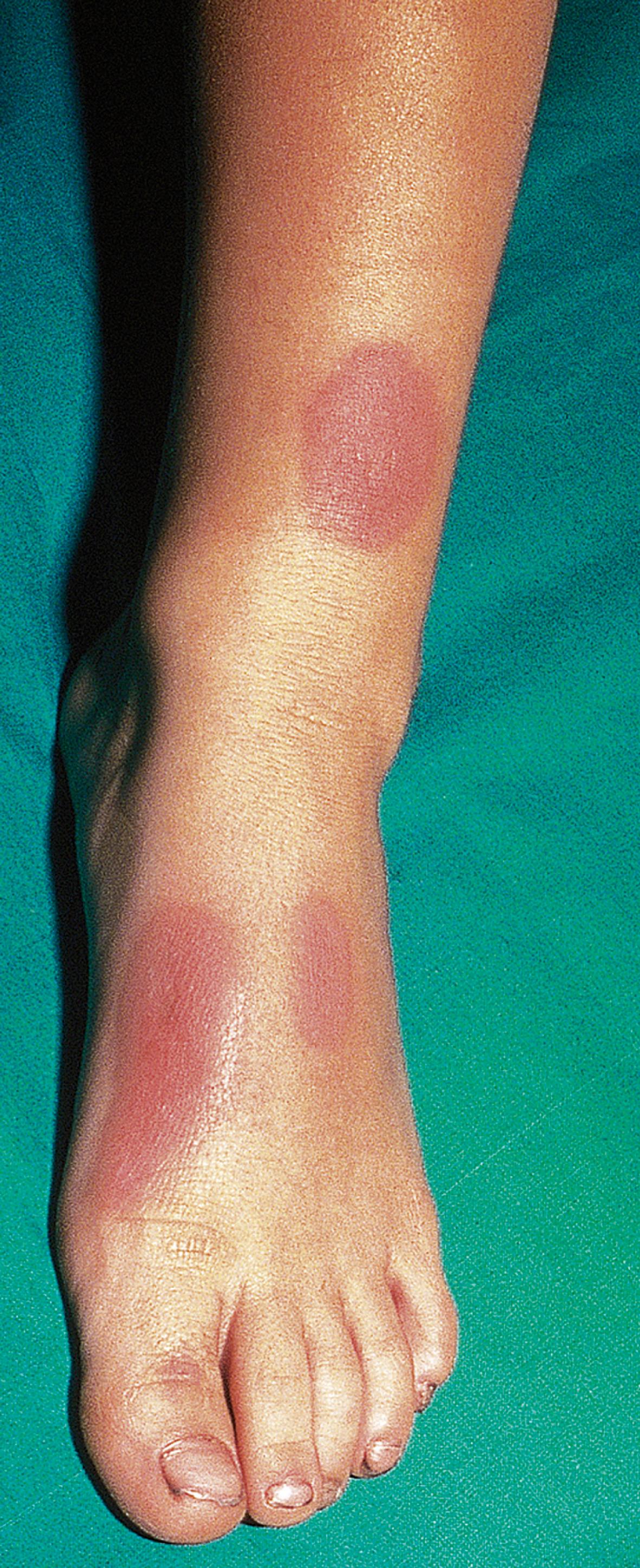
Pyogenic arthritis, pyoderma gangrenosum, and acne (PAPA) is an autosomal dominant inherited syndrome caused by variants in PSTPIP1 (see Table 54.2 ), which leads to hyperphosphorylation of PSTPIP1 and increased interaction with pyrin, leading to increased IL-1β production. PAPA begins in childhood with episodes of sterile monoarticular arthritis, and later in life pyoderma gangrenosum–like ulcerative skin lesions and cystic acne ( Fig. 54.2 ). The episodes of arthritis are the most common presentation, start in early childhood, and typically affect one to three joints at a time. The joint effusions are typically neutrophil-rich and sterile. Treatment of the arthritis with surgical drainage or treatment with intraarticular or systemic steroids has shown benefit in resolving arthritis. Several reports demonstrated successful treatment with an IL-1 receptor antagonist (anakinra) or other IL-1 blockers (rilonacept, canakinumab).
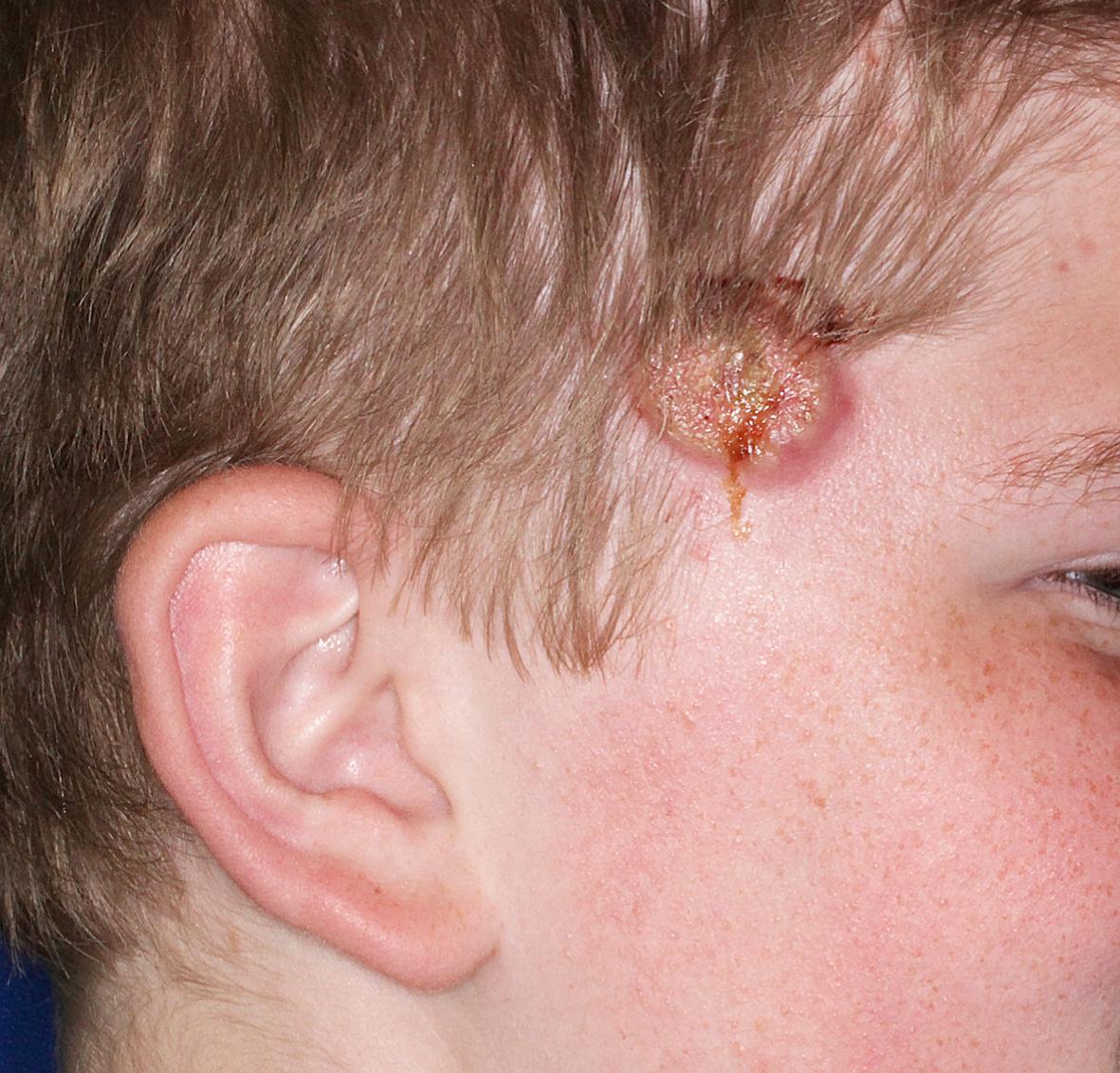
Cryopyrin-associated periodic syndromes (CAPSs) are a spectrum of autoinflammatory disorders that are inherited in an autosomal dominant manner due to variants in the NLRP3 gene (see Table 54.2 ). NLRP3 encodes cryopyrin, a protein that is part of the inflammasome. Variants that cause CAPS prevent autoinhibition of the cryopyrin protein, resulting in spontaneous activation of the inflammasome and excessive production of IL-1β.
CAPS consists of three diseases: familial cold autoinflammatory syndrome (FCAS), Muckle-Wells syndrome (MWS), and neonatal-onset multisystem inflammatory disorder (NOMID), which represent a spectrum of disorders that present with recurrent or continual systemic inflammation, rash, fevers, arthritis, neurologic deficits, and amyloidosis. FCAS is the mildest form of this disorder that presents with fevers, an evanescent rash, headache, conjunctivitis, and joint pain after generalized cold exposure. Although the rash can have some visual features of urticaria, it is macular without signs of mast cell degranulation, and is histologically characterized by a neutrophilic infiltrate. MWS presents similarly to FCAS, but cold exposure is not necessary for symptoms to occur ( Fig. 54.3 ). Unlike FCAS, chronic meningitis occurs with papilledema and sensorineural hearing loss, joint pain and swelling is more severe, and untreated, amyloidosis develops over time. NOMID is the most severe variant of CAPS. Like MWS, all patients with NOMID exhibit a rash at or shortly after birth ( Fig. 54.4 ). Neurologic symptoms, such as aseptic meningitis, headache, cerebral atrophy, uveitis, hearing loss, and intellectual disability, are common and severe. In NOMID and MWS, chronic inflammation of the joints leads to a chronic arthropathy with epiphyseal and patellar overgrowth. FCAS, MWS, and NOMID exhibit laboratory evidence of an acute-phase response with leukocytosis, neutrophilia, anemia, thrombocytosis, and elevated ESR and CRP levels.
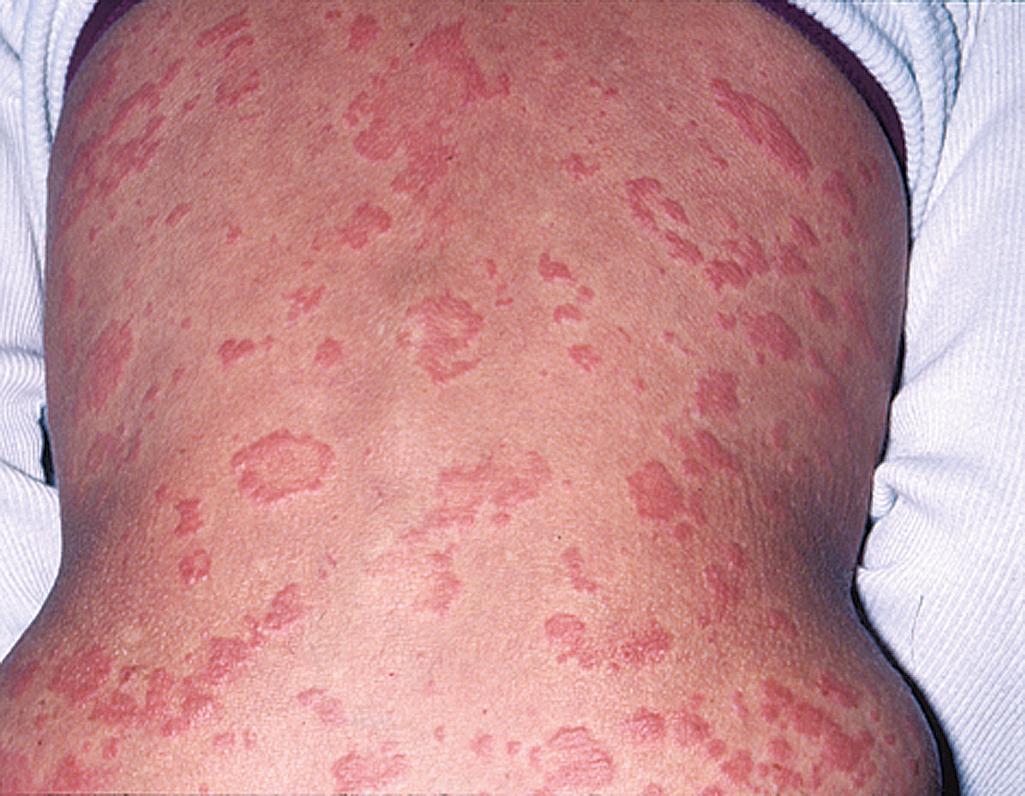
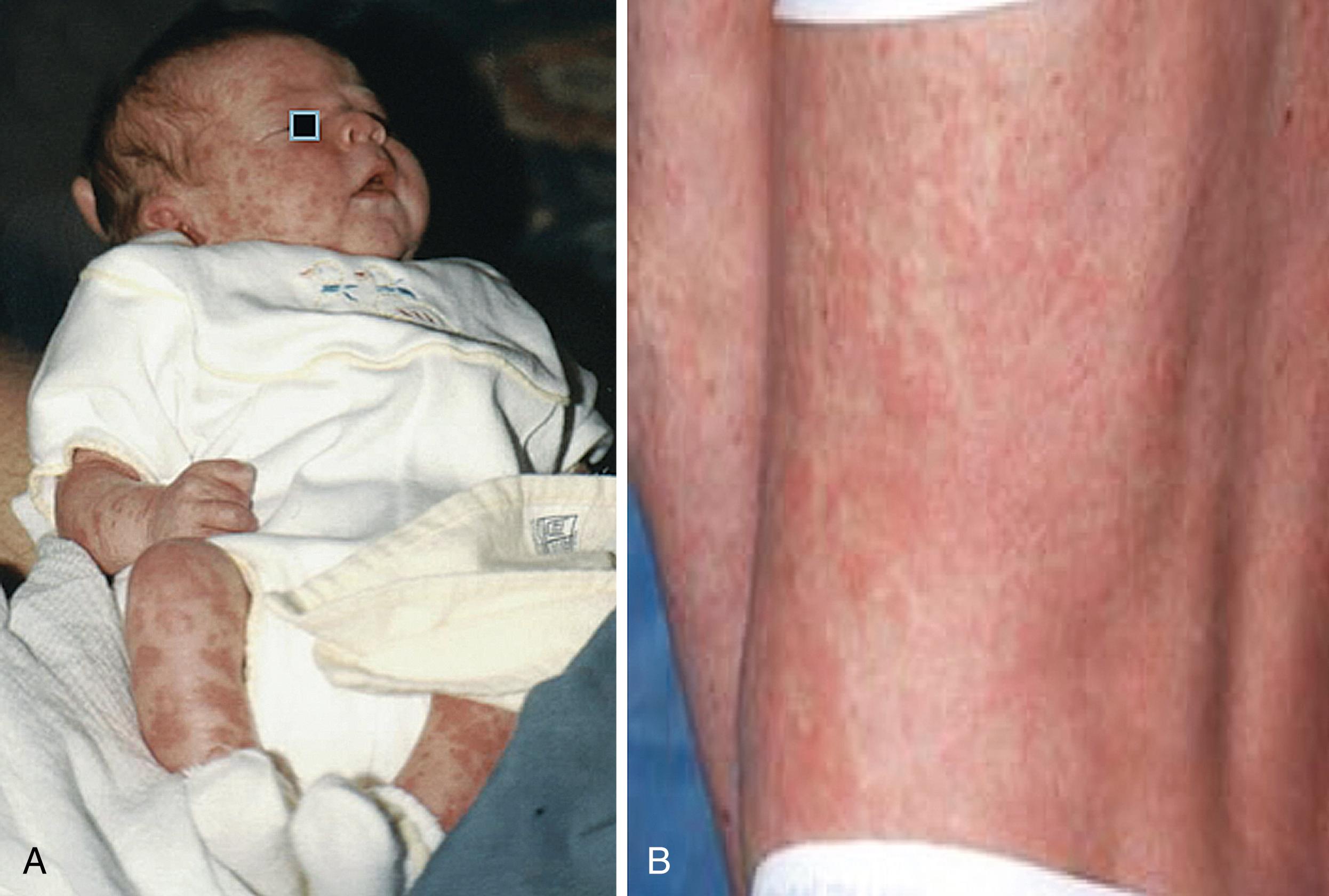
IL-1 inhibitors (anakinra, rilonacept, canakinumab) are now the treatment of choice for these disorders based on their ability to induce rapid and sustained clinical response. Laboratory abnormalities typically normalize in days, and the rash responds rapidly. Importantly, IL-1 blockade improves long-term morbidity such as hearing loss, joint deformity, and amyloidosis.
Hyperimmunoglobulin D syndrome (HIDS) is an autoinflammatory disorder caused by variants in the mevalonate kinase (MVK) gene (see Table 54.2 ). MVK is an enzyme involved in the biosynthesis of cholesterol and isoprenoids. Patients with HIDS have low but detectable MVK enzyme activity resulting in elevated levels of mevalonic acid in the urine, particularly during attacks. Complete absence of MVK results in mevalonic aciduria, an inborn error of metabolism, which is also associated with fevers. It is unclear how variants in MVK lead to an autoinflammatory disease.
The clinical manifestations of HIDS occur at an early age with recurrent fevers with lymphadenopathy, abdominal pain, arthralgia and arthritis, and painful migratory erythematous macules. These episodes may last 4–7 days and are often triggered by stress, trauma, or vaccination. Serum IgD and IgA levels are usually elevated but may be normal. Acute-phase reactants are elevated during attacks. Although high-dose corticosteroids and tumor necrosis factor-α (TNF-α) antagonists have been used with variable success, IL-1β inhibitors appear more effective at preventing the inflammatory episodes. Amyloidosis may occur but is relatively rare.
Deficiency of the IL-1 receptor antagonist (DIRA) is an autosomal recessive disorder due to variants in the IL-1 receptor antagonist gene (IL-1RN) (see Table 54.2 ). IL-1 receptor antagonist (IL-1RA) is a decoy protein that binds to the IL-1 receptor but does not result in signaling, and the absence of IL-1RA in patients with DIRA leads to cellular hyperresponsiveness to IL-1β.
The clinical manifestations of DIRA occur within the first 2 weeks of life and include pustular rash, osteopenia, lytic bone lesions, and prominent systemic inflammation. All patients develop cutaneous pustulosis, and biopsies of the skin lesions revealed a neutrophilic predominance ( Fig. 54.5 ). Respiratory distress, aphthous ulcers, hepatomegaly, and failure to thrive occur, with approximately one-third of infants expiring prior to diagnosis and effective treatment. Bone is prominently involved, with osteopenia, multiple osteolytic lesions, and rib widening. Laboratory abnormalities reflect an acute-phase response with elevated ESR and CRP, leukocytosis, anemia, and thrombocytosis.
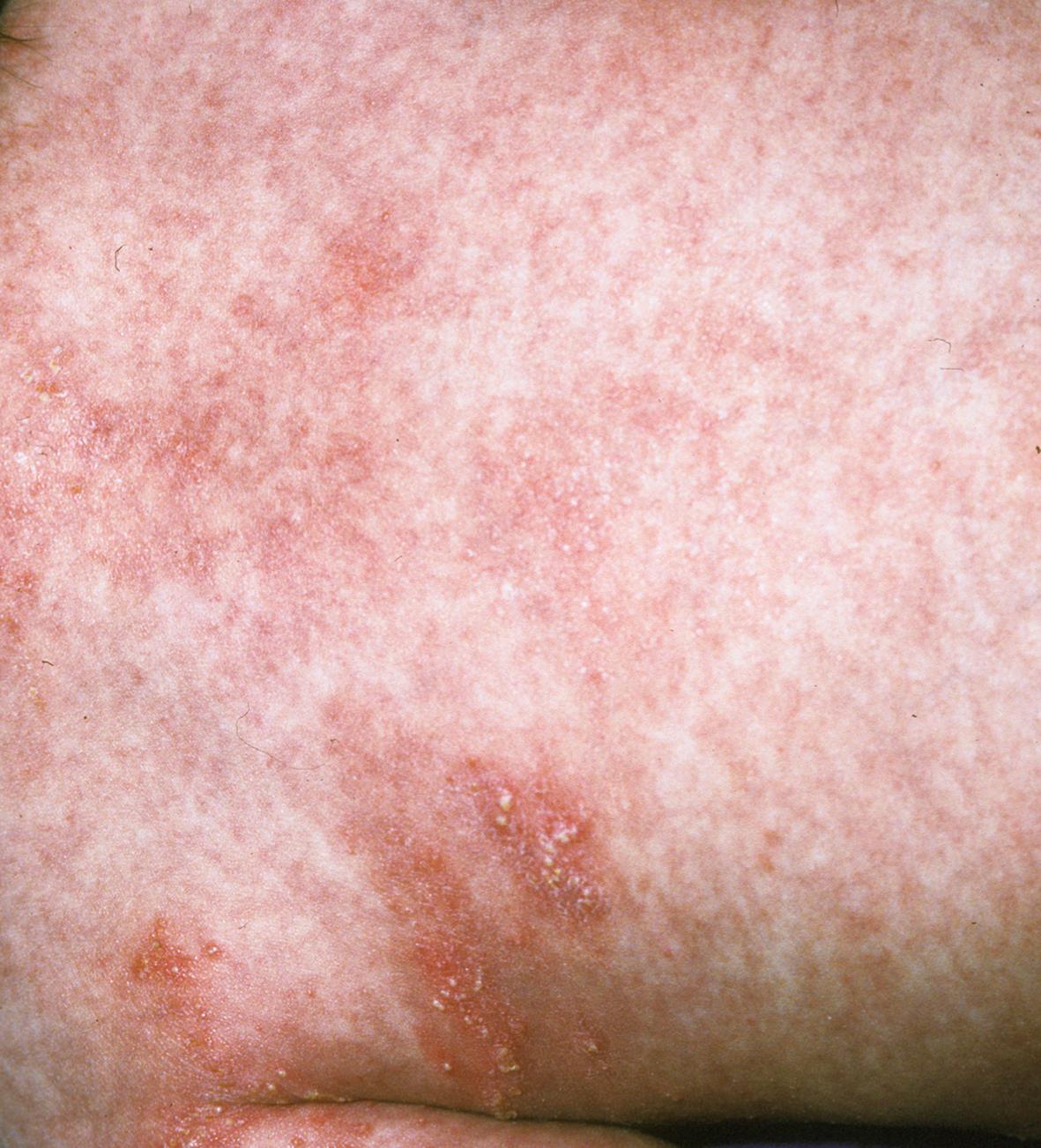
Anakinra, a recombinant IL-1RA, is highly effective in the treatment of DIRA. Anakinra essentially replaces the IL-1RA that patients with DIRA cannot synthesize. The longer-acting anti–IL-1 agents canakinumab and rilonacept also work with the advantage of less frequent dosing compared to anakinra but are considerably more expensive.
TNF receptor–associated periodic syndrome (TRAPS) is an autosomal dominant disease associated with missense variants in the extracellular domain of the TNF receptor 1 (TNFR1) gene (TNFRSF1A) (see Table 54.2 ). The clinical manifestations of TRAPS include recurrent and often prolonged fevers, abdominal pain, and arthralgias. A migratory rash with underlying fascial inflammation and myalgia can be seen, as well as conjunctivitis and periorbital edema ( Fig. 54.6 ). Increased serum levels of CRP, ESR, leukocytosis, and thrombocytosis are evident during and in between attacks. Initial insights into the pathophysiology of this disorder came when patients with TRAPS exhibited low serum levels of soluble TNFR1, suggesting that shedding of TNF receptors acts as a natural antagonist to TNF-α. In support of this, the TNF-α antagonist etanercept has been shown to reduce the severity of symptoms in some cases of TRAPS. However, not all patients with TRAPS have low serum TNFR1 levels, and TNF-α inhibition is not completely effective. Reports have also shown the beneficial effects of IL-1 inhibition and the anti–IL-6 receptor antibody tocilizumab.

Deficiency of adenosine deaminase 2 (DADA2) is an autosomal recessive disorder due to loss of function of CECR1 , which encodes adenosine deaminase 2 (ADA2) (see Table 54.2 ). The clinical manifestations of DADA2 begin in childhood with intermittent fevers, recurrent lacunar strokes, organomegaly, hypogammaglobulinemia, and systemic vasculitides. Pure red cell aplasia, immune thrombocytopenia, neutropenia, and bone marrow failure have been observed. The lacunar strokes begin before the age of 5 years and typically occur during inflammatory episodes. A livedo-like rash is a prominent feature with biopsies showing a predominance of neutrophils and macrophages as well as vasculitis in medium-sized vessels. Some of these patients are diagnosed with early-onset polyarteritis nodosa. Treatment with glucocorticoids, TNF-α inhibitors, and IL-1 blockers has been utilized with some benefit. Hematopoietic stem cell transplantation is increasingly the treatment of choice for this disorder.
Another group of disorders that result in spontaneous inflammation are known as interferonopathies ( Fig. 54.7 and Table 54.4 ). Interferonopathies are genetic defects that result in the spontaneous production of type 1 interferons, which leads to inflammation and characteristic features. The genetic defects occur in genes that process or detect intracellular nucleic acids, a sign of viral infections, resulting in the production of type 1 interferon and subsequent systemic inflammation. Since interferons signal through Janus kinases, which results in inflammation, targeted therapies with Janus kinase inhibitors have shown promise.
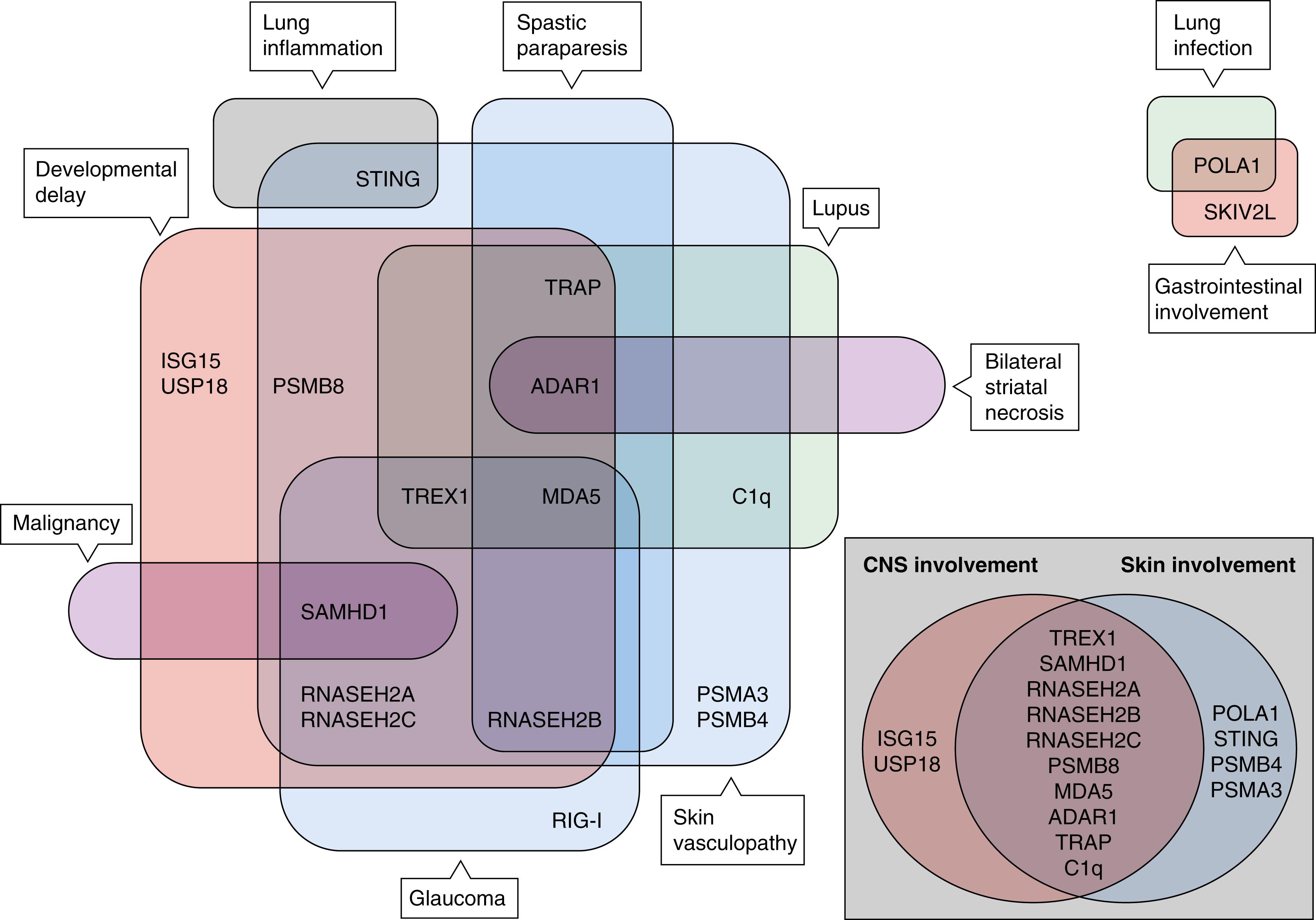
| Disease | Gene | Protein Function | Inheritance | Symptoms |
|---|---|---|---|---|
| Aicardi-Goutières syndrome (AGS) type 1 | TREX-1 | 3’-5’ DNA exonuclease | AR and AD | Classical AGS |
| AGS2 | RNASEH2B | Components of RNase H2 complex. Removes ribonucleotides from RNA-DNA hybrids | AR | Classical AGS |
| AGS3 | RNASEH2C | Classical AGS | ||
| AGS4 | RNASEH2A | Classical AGS with dysmorphic features | ||
| AGS5 | SAMHD1 | Restricts the availability of cytosolic deoxynucleotides | AR | Mild AGS, mouth ulcer, deforming arthropathy, cerebral vasculopathy with early-onset stroke |
| AGS6 | ADAR | Deaminates adenosine to inosine in endogenous dsRNA, preventing recognition by MDA5 receptor | AR and AD | Classical AGS, bilateral striatal necrosis |
| AGS7 | IFIH1 | Cytosolic receptor for dsRNA | AD | Classic or mild AGS, asymptomatic |
| Retinal vasculopathy with cerebral leukodystrophy (RVCL) | TREX-1 | 3’-5’ DNA exonuclease | AD | Adult-onset loss of vision, stroke, motor impairment, cognitive decline, Raynaud, and liver involvement |
| Spondyloenchondrodysplasia (SPENCD) | ACP5 | Lysosomal phosphatase activity | AR | Spondyloenchondrodysplasia, immune disregulation, and in some cases combined immunodeficiency |
| STING-associated vasculopathy with onset in infancy (SAVI) | TMEM173 | Transduction of cytoplasmic DNA-induced signal | AD | Systemic inflammation, cutaneous vasculopathy, pulmonary inflammation |
| Proteasome-associated autoinflammatory syndrome (PRAAS) | PSMB8 | Part of the proteasome complex | AR | Autoinflammation, lipodystrophy, dermatosis, hyperimmunoglobulinemia, joint contractures, short stature |
| ISG15 deficiency | ISG15 | Stabilizes USP18, a negative regulator of type 1 interferon | AR | Brain calcifications, seizures, mycobacterial susceptibility |
| Singleton-Merten syndrome (SMS) | IFIH1 | Cytosolic receptor for dsRNA | AD | Dental dysplasia, aortic calcifications, skeletal abnormalities, glaucoma, psoriasis |
| Atypical SMS | DDX58 | Cytosolic receptor for dsRNA | AD | Aortic calcifications, skeletal abnormalities, glaucoma, psoriasis |
| Trichohepatoenteric syndrome (THES) | SKIV2L | RNA helicase | AR | Severe intractable diarrhea, hair abnormalities (trichorrhexis nodosa), facial dysmorphism, immunodeficiency in most cases |
STING-associated vasculopathy of infancy (SAVI) is an autoinflammatory disorder that presents with intermittent low-grade fevers; rashes on the cheeks, nose, or digits; myositis; arthritis; and evidence of interstitial lung disease (see Table 54.2 ). The vascular involvement can be significant resulting in ulceration of the distal extremities with tissue infarcts ( Fig. 54.8 ). Autosomal dominantly inherited variants in the signaling molecule STING, which senses altered intracytoplasmic double-stranded DNA levels, lead to its spontaneous activation and the production of type 1 interferon. Currently there is no treatment, although Janus kinase inhibitors are available based on in vitro studies and case reports.
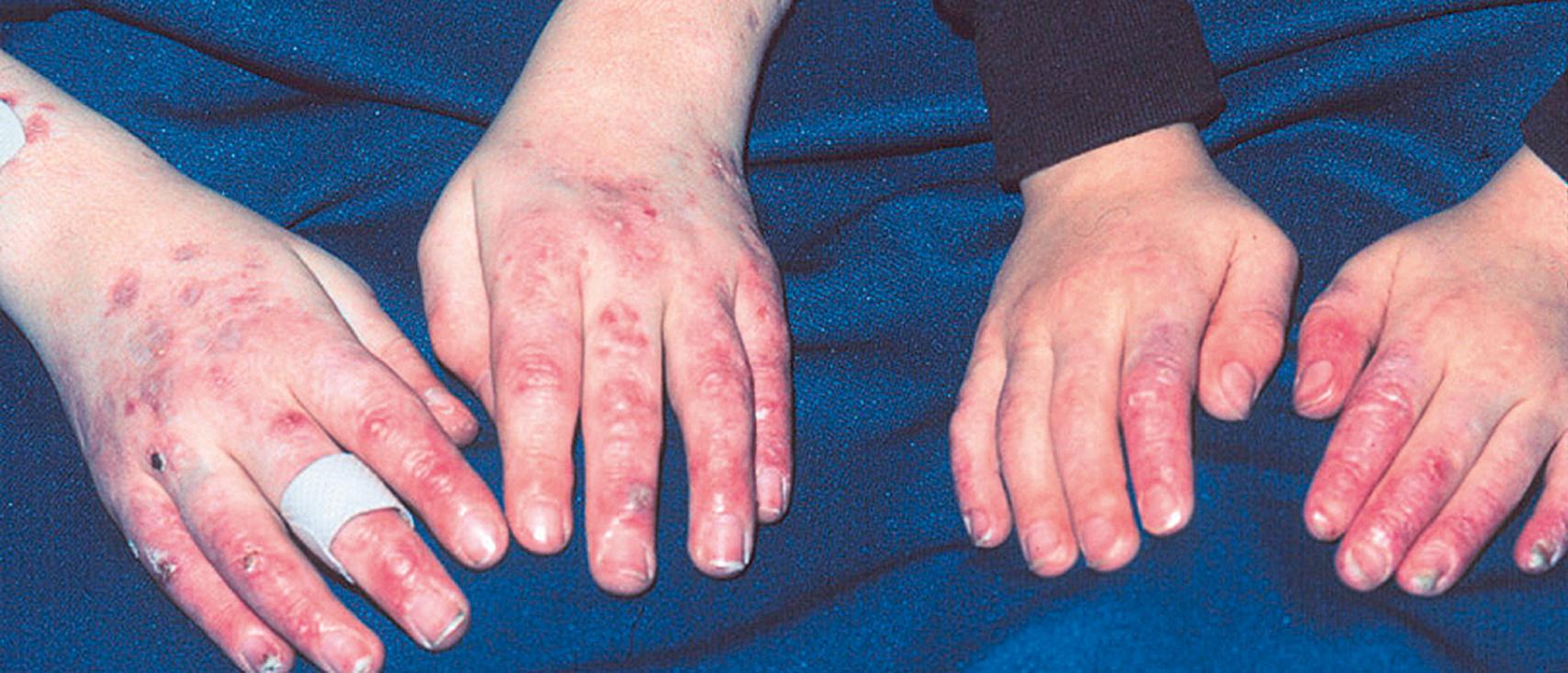
Misfolded or damaged proteins are degraded by the proteasome, and defects in the proteasome lead to buildup of dysfunctional or misfolded proteins. This buildup occurs during viral infections and is sensed by the cell with resultant interferon production. Chronic atypical neutrophilic dermatosis with lipodystrophy and elevated temperature (CANDLE) occurs due to genetic defects in the proteasome with resultant type 1 interferon production (see Table 54.2 ). Mild infections, cold, or stress affects metabolic demands, which can precipitate episodes of inflammation in this disorder. Features include early-onset recurrent fevers; rashes on the fingers, toes, face, and ears; and erythematous or violaceous periorbital and perioral edema. Erythematous nodules, plaques, and purpuric lesions can occur, and biopsies demonstrate leukocytoclastic vasculitis with fibrinoid necrosis and panniculitis. Labs are significant for elevated inflammatory markers, chronic anemia, thrombocytosis, and hypergammaglobulinemia. Over time lipodystrophy, aseptic meningitis, and synovitis develop. Autosomal recessive loss-of-function variants in the PSMB8 gene, which codes for the proteasome subunit β5i, is the classic defect, but genetic variants in the other subunits of the proteasome may also result in CANDLE syndrome.
Nuclear factor-κB (NF-κB) family members are sequestered in the cytoplasm bound to inhibitory proteins, and when activated these proteins are degraded via the ubiquitin pathway, allowing for the nuclear translocation of NF-κB and the transcription of many inflammatory proteins. De-ubiquitinating enzymes inhibit this process, and genetic variants in two of these proteins, otulin and A20, lead to autoinflammatory disorders. Otulipenia , due to homozygous loss-of-function variants in the FAM105B gene that encode otulin, may present with episodes of recurrent fevers, joint swelling, painful nodular red rash, gastrointestinal inflammation with diarrhea, and failure to thrive. Biopsies of the rash will show a neutrophilic dermatosis and small/medium-vessel vasculitis. A20 haploinsufficiency is an autosomal dominantly inherited autoinflammatory disorder caused by genetic variants in the TNFAIP3 gene (see Table 54.2 ). Patients present with systemic inflammation, oral and genital ulcers, uveitis, and fevers similar to familial Behçet disease. Other autoinflammatory disorders, such as Blau syndrome, have also been postulated to lead to NF-κB activation. Blau syndrome is an autosomal dominant disease caused by variants in NOD2 that result in spontaneous activation of the NOD2 protein, activation of NF-κB, and production of proinflammatory cytokines. Blau syndrome was originally described as a granulomatous disease affecting the skin, joints, and uveal tract and should be considered in any individual presenting with early-onset sarcoidosis. Blau syndrome presents with a boggy synovitis of large joints, particularly the wrists and ankles, and an erythematous papular rash similar to erythema nodosum. Biopsy of these lesions demonstrates noncaseating granulomas. Unlike sarcoidosis, respiratory involvement and hilar adenopathy are rare, although granulomatous liver disease, cranial neuropathies, and large-vessel vasculitis can occur. Laboratory studies in Blau syndrome are typically normal, although elevated ESR and angiotensin-converting enzyme levels can be seen, and hypergammaglobulinemia can occur. Most patients with Blau syndrome have been treated with corticosteroids, although limited reports have shown effectiveness of infliximab, thalidomide, and possibly anakinra.
Become a Clinical Tree membership for Full access and enjoy Unlimited articles
If you are a member. Log in here